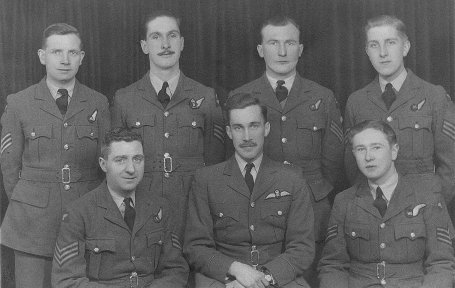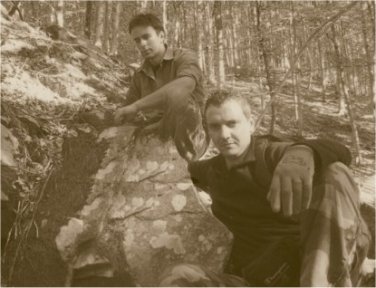THE ANGELS OF THE MOUNTAIN
By Francesco Sabini
Adapted from the Italian translation
by William Hillman - nephew
of pilot F/L Donald Hillman
Reference Source: The
Sabini Website
INTRODUCTION:
This article relates a tragic story from the distant
summer of 1944: a British Halifax bomber, loaded with aid for the Resistance,
crashed near Santa Maria del Taro. There were seven deaths. The description
of the search for the remains is by Francesco Sabini, history buff and
an expert in the search for wrecked aircraft. The local Apennines are very
rich in places where the air disasters have occurred, especially in the
last period of the war. These crash sites which attract hundreds of fans
of "aerial archeology" and experts in history.
While reading a book describing the activities of partisans
in our area, I was intrigued by the description of the crash of a Halifax
bomber in the Santa Maria del Taro area. On the night of June 24, 1944,
a large four-engined allied bomber/transport plane, assigned to the drop
supplies to the partisans, crashed into a mountain -- the entire crew perished.
As a lover of history and aviation, I was very curious and wanted to know
more about this tragic event which happened in our mountains.
I contacted my friend and fellow researcher Alessandro
Sabini (both are part of the GRRS Montegroppo - Recovery of Historical
Research Group), well-known military expert of World Wars I and II.
His interest in this event prompted us to plan an on-the-ground inspection
as soon as weather conditions permitted.
Meanwhile I started more research. The clues were very
few. Most of the information I found consisted of old vague accounts,
but I kept digging. Finally I reached a breakthrough in my inquiries. Through
acquaintances, I tracked down an old man who had been witness to the incident
and had a wealth of information to share. He recalled that on the night
of June 24, 1944, about two o'clock, the silence was broken by a dull roar
that echoed across the high Valtaro and then, from the side of a mountain
he could see flames reaching into the night sky. It was clear that a plane
of some kind had crashed, but no one had the courage to force their way
through the dense bush in the darkness of night.
At dawn, several rescue teams and many onlookers headed
for the crash site. When they arrived they came upon an horrific scene:
dozens of uprooted, broken and burned beech trees and a huge still-smoking
crater were the first images that presented themselves to the rescuers.
An acrid smell of burning and death enveloped the surrounding area ...
it was clear that no one had survived!
Aircraft parts were stewn over a large radius and body
parts of the young airmen were scattered everywhere. The scene was terrifying
and blood curdling. The full recovery of their bodies was very difficult,
since human remains were everywhere, even on the branches of the bushes
and trees.
On an escarpment the rescuers found remains in an airplane
seat. When they tried to remove the seat they leaped backwards. They saw
with dismay that, still connected with the seat belts, there was a horribly
mutilated and decapitated body of one of the young aviators.
Nearby, among the stones of the stream, they came upon
a hand still wrapped in a glove with the fist squeezed around a photograph
of his loved ones.
The plane was carrying bombs, but also a precious cargo
of weapons, ammunition, clothing, food, tobacco, drugs and money for the
partisans. These resistance fighters were busy clearing out German troops
to make way for the Monterosa Alpine Division. That night the fighters
waited in vain, hidden around the signal beacons, waiting for the help
from the skies which never came.
Scattered among the wreckage was a huge quantity of arms
and ammunition of various kinds, such as Mills type hand grenades. Many
had exploded due to the fire, and many were damaged and therefore dangerous,
but several were still in good condition.
The inhabitants of the area recovered any of the cargo
still in good condition, but also the aluminum wreckage of the plane. Aluminum
was a valuable material at that time -- it was to be used to build roofs
and doors of farmhouses and stables and was sold to a wrecker in Liguria.
The bodies of the unfortunate aviators were gathered and
pitifully recomposed by the population in seven coffins, without being
identified. Don Celso Mori celebrated Holy Mass, and the entire population
of the parish covered the coffins with flowers. A large group of armed
partisans provided military and service honours.
The bodies were buried in the local cemetery and were
resurrected only after liberation by order of the Allies. They were then
transported to the Staglieno Cemetery in Genoa.
I listened to this tragic story from the old man, and
felt very sad and touched to learn that age and time have not erased the
names of the crew from his mind. I thanked him for his words, which
to me were invaluable.
Our next step was to locate the exact location where the
disaster had occurred. I contacted my friend Alexander again and we made
plans to search the area for the crash site.
On a cool spring morning, armed with compass, map and
everything we thought we would need, we were ready. We set off for the
meta high mountain in the municipality of Tornolo and Liguria. The research
would be difficult, it will be like finding a needle in a haystack. We
reached the area by jeep and started to realize how vast it was going to
be to explore -- but we weren't intimidated. So, with one eye on the map
and compass in hand, we set out.
We were filled with awe at the beauty of these inaccessible
places, where nature is still unspoiled. We found a stream where the clear
water flowed between the rocks and, according to the map, we were sure
we were going in the right direction.
Then the long awaited moment. We turned on our metal detectors,
and, after some adjustment tests, we began to test the waters, while slowly
approaching the ridge of the mountain. After about an hour's walk our instruments
had not yet found anything and disappointment started to set in. But, suddenly
Alexander's shout broke the silence of the forest.
"Hey, over Here! I found something."
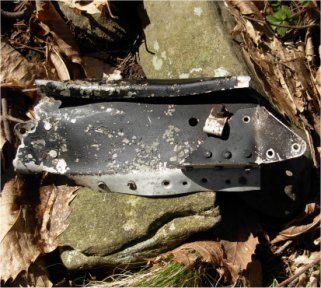 .
.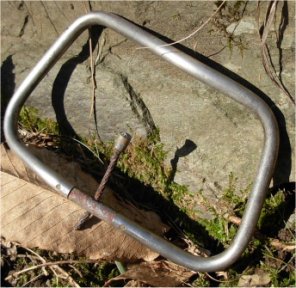
I ran to him and, just below the leaves, we found a piece
of molten aluminum, which was certainly a fragment of the plane! I soon
discovered something else: a handle for the opening of a parachute. There
was no longer any doubt: this was the place where the plane fell!
We went along the creek and there, without even using
the instruments, we uncovered dozens of pieces of scrap from the aircraft
cabin, fragments of the engine, and even the remains of a Swiss watch.
Sixty-six years ago this gold case was strapped to the wrist of one of
the crew members. Many of the pieces bore the initials AM (Air Ministry)
stamped with the English royal crown in the middle. It was now clear that
this was a plane of the Royal Air Force.
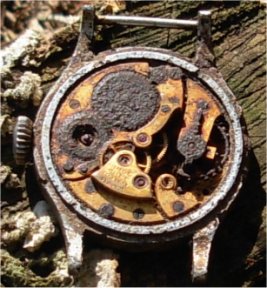 .
.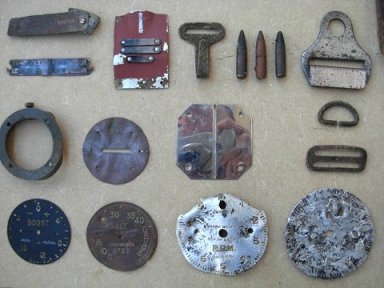
Meanwhile, while my friend was intent in research, I sat
on a rock on the bank of the river. As I paused to observe the clear water
running down the valley and to listen to the sound of the wind blowing
through the tall beeches, my mood changed rapidly.
My mind took a leap back in time and I thought about that
dark night when seven young boys died in this place so beautiful, yet so
dismal.
For a moment I thought I could see their faces all around
me -- faces that stared at me, as if they were angels to watch over the
place, angels looking down through the years and over the modern indifference
that brings forgetfulness and dims events of the past. Not a flower,
not a plaque to remember those young lives shattered against the mountain.
We were about to return home when the last sound of the
metal detector drew our attention to an important discovery: a plaque with
the inscription "TYPE HALIFAX" and some numbers. I know planes pretty well,
I know that Halifax is the kind of four-engine used by the RAF (Royal Air
Force). What luck to find a fragment with the name of the aircraft in the
middle of 16,000 kg of aluminum! Now we knew that plane was fundamental
to our research!
The day had almost come to an end, the rays of sunset
stretched our shadows across the ground, and we were tired but satisfied.
During the following days I started to surf the internet
in search of names and faces of those seven poor boys just to get a little
information:
* Pilot F/L Donald Ernest Hillman J/17893 RCAF died
at age 26 ~ Canadian pilot navigator P/O
* Nicholas Holyk J/92012 RCAF died 35 years Canadian
engineer SGT
* Arthur Pinder 1538939 RAFVR (Volunteer Reserve) died
gunner SGT
* Dixon Finlayson 1824006 RAFVR 35 years died English
gunner SGT
* John Michael Sumner 1801255 RAFVR died pointer SGT
* James Ross Robertson J161315 RCAF died 21 years Canadian
radio operator SGT
* Edward Geoffrey Chapman 1323119 RAFVR 21 years died
English
The plane, type II Halifax, serial number JP237, was part
of the "148 Squadron" of the RAF and took off from a base in Brindisi at
20:11 on a secret mission called "SOUND 1", which should have been part
of 13 aircraft, but that, due to technical problems, were reduced to 10.
All carried out their mission successfully except precisely that of Hillman,
though he was an excellent pilot: After two there was no further radio
contact and the aircraft was reported missing to the north-east of Genoa,
between Santa Maria del Taro Borgo Val di Taro. Causes of the crash are
not as yet entirely clear, the most likely instance being brought down
by the enemy air defenses in the skies of Liguria or an error of altitude
assessment altitude of the pilot.
Sometime later, Alexander and I went back to the crash
site, where we made a stone altar, laying on it a few pieces of the plane
and a bouquet of flowers in memory of those young lives cut short so tragically
and forgotten.
After a few minutes of silence a few drops of rain began
to bathe our faces. It was time to return home and, while we rapidly
climbed down the mountain, a dense fog began to descend. I looked back
to the altar one last time and, for a moment, I seemed to see seven angels
smiling and watching us before the thick fog engulfed them and blanketed
them from sight.
I dedicate this article to my daughter Rachel and her
generation to let them know a small part of history, because those who
do not know history are doomed to repeat it ...
Information for this article is drawn in part from the
book 'On the ground scenderem for battle' of Ferrari and Ferruccio
and Bill Hillman's websites www.airmuseum.ca/rcaf/donald.html
and www.hillmanweb.com/rcaf/donald
Francesco Sabini
Read the original translation from Italian at the
Sabini
Website
The version on this page was adapted by William Hillman
